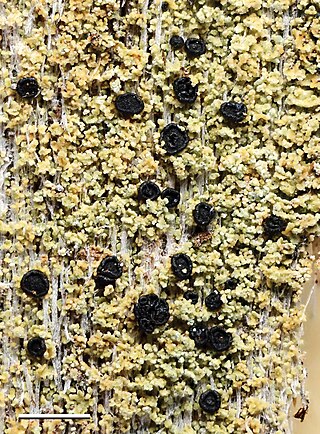
Umbilicaria vellea is a species of lichen in the genus Umbilicaria. It is sometimes called navel lichen. It is found in North America and Europe in alpine and arctic habitats. It is similar to the species Umbilicaria americana, which has a more southern distribution.

Lasallia is a genus of lichenized fungi in the family Umbilicariaceae.

The Umbilicariales are an order of lichenized fungi in the subclass Umbilicariomycetidae, class Lecanoromycetes. It contains five families: Elixiaceae, Fuscideaceae, Ophioparmaceae, Ropalosporaceae, and Umbilicariaceae. Umbilicariales was proposed as a new order in 2007, while the subclass Umbilicariomycetidae was proposed in 2013.

Fuscideaceae is a family of lichen-forming fungi in the order Umbilicariales. It contains five genera and about 55 species of crustose lichens.

Lasallia pustulata is a species of lichen in the Umbilicariaceae family of fungi. It is the type species of its genus Lasallia.
Józef Motyka was a Polish botanist and lichenologist.

Umbilicaria crustulosa, the crusty navel lichen, is a lichen of the genus Umbilicaria in the family Umbilicariaceae.
Helge Thorsten Lumbsch is a German-born lichenologist living in the United States. His research interests include the phylogeny, taxonomy, and phylogeography of lichen-forming fungi; lichen diversity; lichen chemistry and chemotaxonomy. He is the Associate Curator and Head of Cryptogams and Chair of the Department of Botany at the Field Museum of Natural History.

Xylopsora is a genus of lichenized fungi, belonging to the family Umbilicariaceae.

Umbilicaria polyphylla, commonly known as petaled rock tripe, is a widely distributed species of saxicolous lichen in the family Umbilicariaceae. It was first described by Carl Linnaeus in his 1753 work Species Plantarum as Lichen polyphyllus. German botanist Johann Christian Gottlob Baumgarten transferred it to the genus Umbilicaria in 1790. The lichen has a dark brown to black thallus that measures 2–6 cm (0.8–2.4 in) in diameter. The upper surface is smooth, while the lower surface is sooty black. It grows on exposed rocks, typically in arctic-alpine habitats.

Umbilicaria deusta, commonly known as peppered rock tripe, is a widely distributed species of saxicolous lichen in the family Umbilicariaceae. It was first described by Carl Linnaeus in his 1753 work Species Plantarum as Lichen polyphyllus. German botanist Johann Christian Gottlob Baumgarten transferred it to the genus Umbilicaria in 1790. The lichen has a dark brown to nearly black thallus that typically measures 1–5 cm (0.4–2.0 in) in diameter. The upper surface is covered with tiny black dots that are granular isidia; the lower surface is the same colour as the upper surface, and is either smooth or covereds with dimples. It grows on exposed boulders and rocky outcrops.

Umbilicaria hyperborea, commonly known as blistered rock tripe, is a species of foliose lichen in the family Umbilicariaceae. It is widely distributed in arctic and alpine regions.
George Albert Llano, born Jorge Alberto Cecilio Perez y Llano, was a Cuban-born American polar explorer and botanist who specialized in the field of lichenology. He was an expert in the Umbilicariaceae.
Umbilicaria maculata is a species of saxicolous (rock-dwelling) umbilicate lichen in the family Umbilicariaceae. It is found in high-elevation alpine locations in Poland and France.
Umbilicaria murihikuana is a rare species of saxicolous (rock-dwelling) lichen in the family Umbilicariaceae. It is endemic to New Zealand, where it occurs in mountainous, high-rainfall areas of Otago and Southland. It grows on exposed rocks and boulders at altitudes between 1,000 and 1,500 m, in subalpine to alpine habitats.
Fulgidea is a genus of lichen-forming fungi in the family Umbilicariaceae. It has two species of squamulose lichens that grow on bark and on wood.

Umbilicaria angulata, commonly known as the asterisk rocktripe, is a species of saxicolous (rock-dwelling), foliose lichen in the family Umbilicariaceae. It is found in northwestern North America and east Eurasia, where it grows on acidic rock.
Umbilicaria semitensis, commonly known as Yosemite rock tripe, is a species of foliose lichen in the family Umbilicariaceae. It occurs in the western regions of northern North America, from southern California to southern Oregon.
Umbilicaria nodulospora is a species of foliose lichen in the family Umbilicariaceae, discovered on steep rock faces of old lava flows in California and Oregon, USA. This species is distinguished by the unique shape of its ascospores and its DNA sequence, which does not closely relate to any known species within its family.









